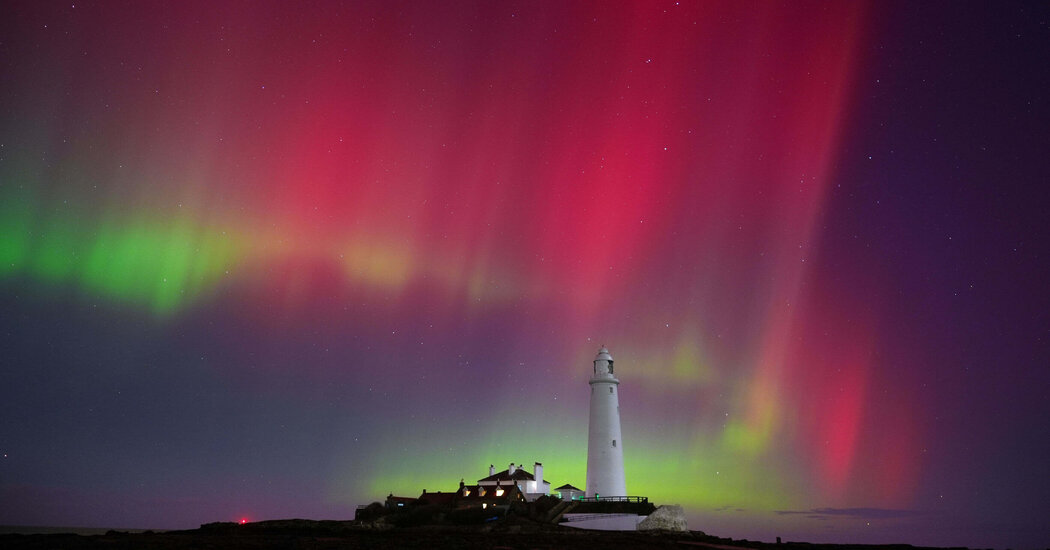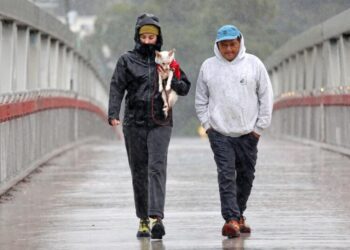
A surprisingly powerful northern lights display dazzled much of the northern hemisphere on Tuesday, reaching points as far south as Florida in the United States and Austria in Europe. Another spectacle is expected on Wednesday.
“It is possible this will be as impactful as last night’s event,” said Mike Bettwy, a meteorologist and the operations chief for the Space Weather Prediction Center, a part of the National Oceanic and Atmospheric Administration.
First: what’s going on?
On Tuesday night, the lights became visible following what’s called a coronal mass ejection — a burst of charged particles from the sun. These particles carry their own magnetic fields, and when they collide with Earth’s magnetic field, they trigger a geomagnetic storm, forming the aurora.
There were actually two explosions of material from the sun that reached Earth on Tuesday and material from a third was expected to enter the atmosphere later Wednesday.
Shawn Dahl, a forecaster at the Space Weather Prediction Center, said in a social media post on Tuesday night that the third ejection was the most energetic and strongest of the three.
The Space Weather Prediction Center has a scale for these storms, which runs from G1, a “minor” storm, to G5, or an “extreme” storm. The strength of the storm helps dictate how strong the aurora is and how far south it can be seen. That’s why the lights can be somewhat common in northern places like Iceland and Alaska, but a stronger storm can send people as far south as Alabama scrambling to the window.
On Tuesday, the geomagnetic storm reached G4 levels for six hours, and on Wednesday night, levels will likely reach G4 again, or even G5, Mr. Stahl said.
Will the weather get in the way?
Probably.
David Roth, a meteorologist at the Weather Prediction Center, said that large portions of the United States will be blanketed in cloud cover on Wednesday night, especially across the West Coast and the Northeast. However, some of the northern parts of the country, where the aurora is most likely to be visible, are expected to have clearer skies, particularly Minnesota and Wisconsin.
The aurora is once again likely to be visible farther south across the United States as well, from Central California east to the Mid-Atlantic, potentially into the Southeast. In this region, skies are likely to be clear to partly cloudy in parts of the Ohio and Tennessee Valleys, the Carolinas, the southern Appalachians and southern Mid-Atlantic, Mr. Roth said.
The aurora is expected to be more active in Canada than in the United States, as it’s farther north. Canada Space Weather issued a major geomagnetic storm warning. Clouds will likely obscure skies in much of the country. The best chances for clear skies will likely be in the southern portions of provinces of Alberta, Manitoba, Saskatchewan and Ontario.
In Britain, the Met Office Space Weather Operations Center said the aurora was expected to be visible again on Wednesday, though cloud cover could block the view in many places. There was a chance of sightings as far south as England and Wales, where clear spells were expected over eastern England, but the best chances were in the far north of Scotland.
How can I track them?
There are two ways to “see” the lights: with the naked eye, and with a digital camera, which can make even a weaker display pop more vibrantly. Here’s how to capture the best view with your phone.
Popular apps such as My Aurora Forecast and AuroraReach help track the display and can alert you to when conditions are looking good. They rely on NOAA’s Kp-index, which uses a scale from zero to nine to measure solar terrestrial events. The higher the number, the more active the aurora.
A northern lights display that reaches a Kp of two is likely to be dim and visible only in the most northern regions, while a Kp of nine is bright and active and seen as far south as the central United States. On Tuesday night, it exceeded eight in many places.
The aurora can be viewed when it is dark outside, with 10 p.m. to 2 a.m. often being the optimal time, according to NOAA.
Nazaneen Ghaffar is a Times reporter on the Weather team.
The post Missed the Northern Lights on Tuesday? Here’s How to Catch Wednesday’s Show. appeared first on New York Times.


